
A torc, also spelled torq or torque, is a large rigid or stiff neck ring in metal, made either as a single piece or from strands twisted together. The great majority are open at the front, although some have hook and ring closures and a few have mortice and tenon locking catches to close them. Many seem designed for near-permanent wear and would have been difficult to remove.

The Urnfield culture was a late Bronze Age culture of Central Europe, often divided into several local cultures within a broader Urnfield tradition. The name comes from the custom of cremating the dead and placing their ashes in urns, which were then buried in fields. The first usage of the name occurred in publications over grave sites in southern Germany in the late 19th century. Over much of Europe, the Urnfield culture followed the Tumulus culture and was succeeded by the Hallstatt culture. Some linguists and archaeologists have associated this culture with a pre-Celtic language or Proto-Celtic language family. By the end of the 2nd millennium BC, the Urnfield Tradition had spread through Italy, northwestern Europe, and as far west as the Pyrenees. It is at this time that fortified hilltop settlements and sheet‐bronze metalworking also spread widely across Europe, leading some authorities to equate these changes with the expansion of the Celts. These links are no longer accepted.
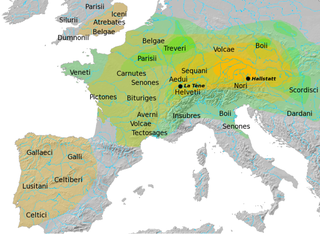
The Hallstatt culture was the predominant Western and Central European archaeological culture of the Late Bronze Age from the 12th to 8th centuries BC and Early Iron Age Europe from the 8th to 6th centuries BC, developing out of the Urnfield culture of the 12th century BC and followed in much of its area by the La Tène culture. It is commonly associated with Proto-Celtic speaking populations.
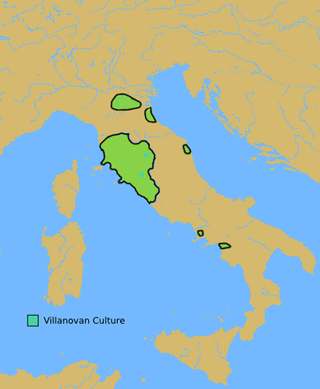
The Villanovan culture, regarded as the earliest phase of the Etruscan civilization, was the earliest Iron Age culture of Italy. It directly followed the Bronze Age Proto-Villanovan culture which branched off from the Urnfield culture of Central Europe. The name derives from the locality of Villanova, a fraction of the municipality of Castenaso in the Metropolitan City of Bologna where, between 1853 and 1855, Giovanni Gozzadini found the remains of a necropolis, bringing to light 193 tombs, of which there were 179 cremations and 14 inhumations.

Prehistoric France is the period in the human occupation of the geographical area covered by present-day France which extended through prehistory and ended in the Iron Age with the Roman conquest, when the territory enters the domain of written history.
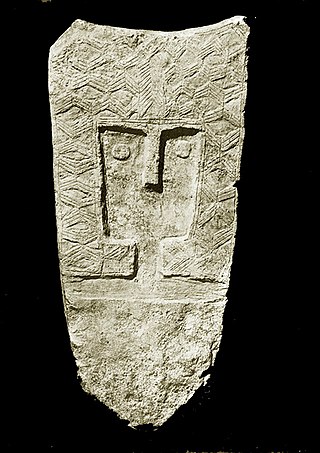
Chasséen culture is the name given to the archaeological culture of prehistoric France of the late Neolithic, which dates to roughly between 4500 BC and 3500 BC. The name "Chasséen" derives from the type site near Chassey-le-Camp (Saône-et-Loire).

The Ipf is a mostly treeless mountain, near Bopfingen, Ostalbkreis, Baden-Württemberg, Germany, with a prehistoric hill fort on its top.

The Vix Grave is a burial mound near the village of Vix in northern Burgundy. The broader site is a prehistoric Celtic complex from the Late Hallstatt and Early La Tène periods, consisting of a fortified settlement and several burial mounds.

Jean-Philippe Lauer, was a French architect and Egyptologist. He was considered to be the foremost expert on pyramid construction techniques and methods.

The "Treasure of Pouan" consists of a number of gold and garnet cloisonné jewels and ornaments, buried with a skeleton uncovered in 1842 at Pouan-les-Vallées and identified as the burial of a 5th-century Germanic warrior. Although the warrior had in the past been identified as that of Theodoric I, modern historians generally believe that this is unlikely. The find is now housed in the Musée Saint-Loup, Troyes.

Lavau is a commune in the Aube department in north-central France in the Grand Est Region. It is situated on the banks of the river Seine
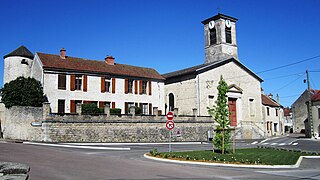
Sainte-Colombe-sur-Seine is a commune in the Côte-d'Or department in eastern France.

The Vorstengraf in Oss is one of the largest burial mounds in the Netherlands and Belgium. The hill was 3 metres high and had a diameter of 54 metres.

The 4th Magritte Awards ceremony, presented by the Académie André Delvaux, honored the best films of 2013 in Belgium and took place on 1 February 2014, at the Square in the historic site of Mont des Arts, Brussels beginning at 8:00 p.m. CET. During the ceremony, the Académie André Delvaux presented Magritte Awards in 21 categories. The ceremony was televised in Belgium by BeTV. Actress Émilie Dequenne presided the ceremony, while actor Fabrizio Rongione hosted the show for the second time.
Claude Rolley was a French archaeologist, emeritus at the University of Burgundy, writer on art, archaeology of Greece and Gaule.
Patrice Brun is a French archaeologist, a professor at Pantheon-Sorbonne University where he teaches European early history as well as theories and methods of archeology.
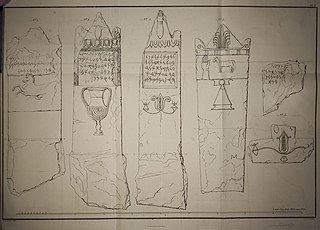
Carthaginian tombstones are Punic language-inscribed tombstones excavated from the city of Carthage over the last 200 years. The first such discoveries were published by Jean Emile Humbert in 1817, Hendrik Arent Hamaker in 1828 and Christian Tuxen Falbe in 1833.

The Graves of Sainte-Colombe-sur-Seine are several burial mounds dating from the 6th century BC, located near the town of Sainte-Colombe-sur-Seine in the Côte-d'Or department in eastern France.
The Armorican Tumulus culture is a Bronze Age culture, located in the western part of the Armorican peninsula of France. It is known through more than a thousand burial sites covered by a tumulus or otherwise. The culture is renowned for some exceptionally richly endowed burials of chieftains of the time, which are contemporary with the elite of the Wessex culture, in England, and the Únětice culture, in Central Europe.
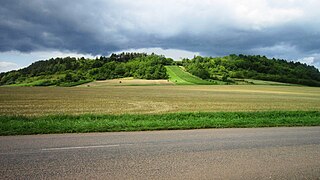
Mont Lassois is a relevant outlier located in the commune of Vix, near Châtillon-sur-Seine in the north of Côte-d'Or. Dominating the upper Seine valley for approximately 100 m and crowned by a 12th century church, Saint-Marcel of Vix, classified as a historic monument, it is currently the subject of excavations and notable archaeological discoveries concerning the Hallstatt civilization.





















